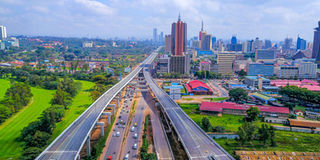Why other East Africans should celebrate the Nairobi Expressway
Sponsored content

A section of the Nairobi Expressway on the day it was being unveiled.
By Evans Ongwae
Why does a 27km stretch of road passing through the Nairobi Central Business District (CBD) matter? This road runs from the bustling Mlolongo town in Machakos County, and meanders through the heart of Nairobi’s central business district to the Westlands suburb, and up to Rironi in Limuru, Kiambu County.
This is the Nairobi Expressway, which President Uhuru Kenyatta launched on July 31, 2022. A significant piece of infrastructure, the road will impact not just Kenyans, but also the people of other Eastern Africa nations who are usually served by the Northern Corridor. This is because traffic to neighbouring nations such as Uganda, Rwanda, Burundi and the Democratic Republic of Congo (DRC), passes through Nairobi and parts of Kiambu County.
It is estimated that using the ordinary passage (Mombasa Road-Uhuru Highway-Chiromo Road-Waiyaki Way), it can take between two to three hours for motorists to cover that 27km distance during peak hours. Usually, peak time is 7am to 9.30am, and also from 5pm to 7.30pm. That is a long time to be stuck in traffic.
Here is a perspective of what that loss of time means: Motorists driving from Nairobi’s CBD to Nyeri through Thika Superhighway can take two to three hours to arrive in Karatina town, which sits on the border with Kirinyaga County – a distance of 126km. Compare 27km and 126km and you will clearly see how time-wasting being stuck in Nairobi traffic can be.
Now, consider the fact that trucks transporting goods from or to Malaba or Busia, on the border between Kenya and Uganda, pass through Nairobi. With the Nairobi Expressway taking some vehicles that would otherwise be using the Mlolongo-Rironi section of the Mombasa Road-Uhuru Highway-Chiromo Road-Waiyaki-Way route, it is clear that motorists will now experience relief.
Trucks that want to join Naivasha Road or Waiyaki Way can branch off to the Southern Bypass. Others can use the Eastern Bypass to link up to the Northern Bypass via Thika Superhighway and join Limuru Road.
For transporters of goods within the Northern Corridor, the Nairobi Expressway gives them respite because they spend less time between Mlolongo and the Southern Bypass, for example. Shorter dwell times on the otherwise normally busy stretch translates to less fuel consumed by their trucks. It also means goods will take a shorter time to arrive in Mombasa Port on the Indian Ocean or on the Busia/Malaba border points. That directly affects the people of East and Central Africa who depend on the Kenyan route to transport goods.


